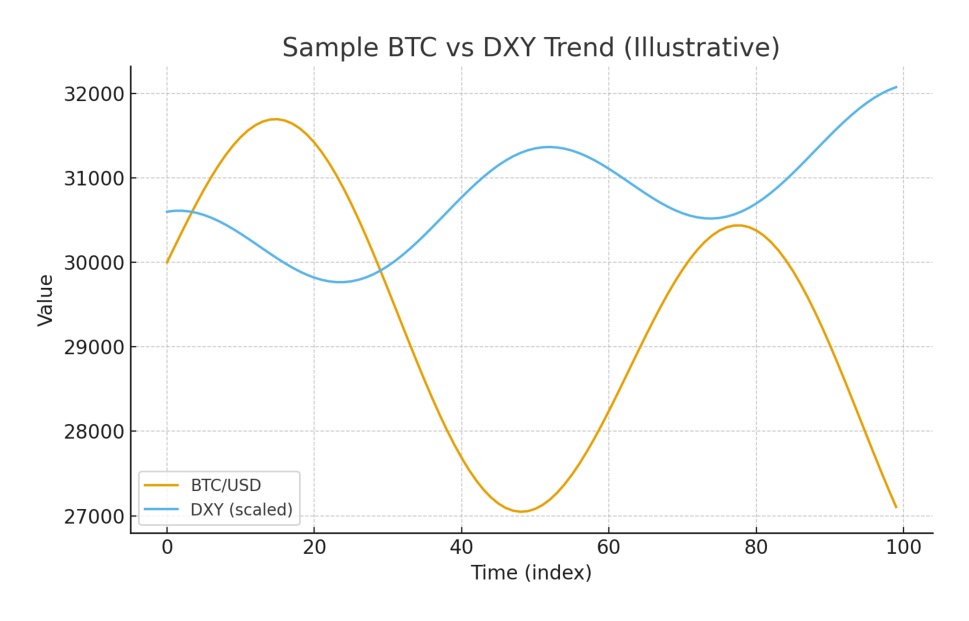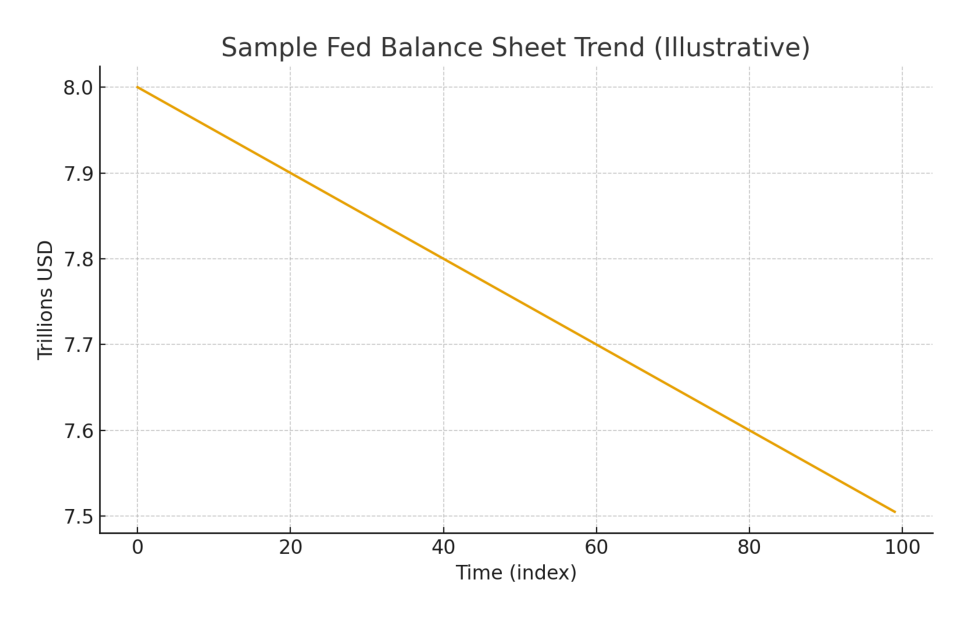
Main Points :
- Markets are split between a 0.25% rate cut and no change at the December 10 FOMC meeting.
- Bitcoin’s decline since early October cannot be explained by the Federal Reserve alone; broad risk-off sentiment and stronger USD have contributed significantly.
- Liquidity indicators suggest that tight conditions may ease in early 2026, potentially benefiting Bitcoin.
- Despite macroeconomic pressure, Bitcoin remains positioned as a scarce asset that reacts strongly when liquidity returns.
- Key structural factors—labor-market cooling, fiscal tightening, and ongoing Fed balance sheet adjustments—will shape BTC’s medium-term trend.
1. Introduction: A Market Divided Ahead of a Key Decision
Bitcoin (BTC) begins December under heavy downward pressure as the market prepares for the Federal Reserve’s interest-rate decision scheduled for December 10. Expectations are almost evenly split: one half anticipates a 0.25% rate cut, while the other expects the Fed to hold rates steady. This division reflects the conflicting signals within the U.S. economy—persistent inflation on one side and clear signs of economic slowdown on the other.
This article explores the macroeconomic conditions shaping Bitcoin’s current trend, evaluates whether BTC can rebound in an environment of tightening financial conditions, and examines how liquidity cycles could shift in Bitcoin’s favor in the months ahead. Recent market research, including employment data, inflation commentary, and monetary-policy behavior, all indicate that Bitcoin’s trajectory is strongly tied to the evolving monetary landscape.
2. The Rate-Cut Debate: Inflation Pressure vs. Economic Slowdown
The CME FedWatch Tool currently assigns almost equal probabilities to a rate cut and a pause. Fed officials emphasize that inflation remains sticky, aggravated by the tariff policies of the Trump administration, which continue to raise import costs and narrow the Fed’s room for easing.
At the same time, a new report from BlackRock highlights clear deterioration in the U.S. labor market, including slowing hiring and declining job openings—signs that typically push the Fed toward policy easing.
This conflicting data has produced one of the most ambiguous macro environments of the past several years, and Bitcoin is caught directly in the middle.
3. Why Bitcoin Weakness Cannot Be Blamed on the Fed Alone
Several analysts note that Bitcoin’s decline began in early October—well before December policy expectations became a market catalyst. A broader set of macro factors is at play:
3.1 The Stronger U.S. Dollar
As tariffs lowered the monthly fiscal deficit and the Fed continued reducing its balance sheet, the U.S. Dollar Index (DXY) strengthened. Historically, Bitcoin and DXY show a strong inverse correlation, making BTC vulnerable to USD rallies.

3.2 Slowing Freight Demand and Housing Weakness
A report by Savvy Wealth notes weakening conditions across:
- Freight shipments
- Housing data
- Corporate cash-flow levels
These signs indicate that risk assets have been under broad pressure, unrelated to any single policy action from the Fed.
3.3 Risk-Off Sentiment Across Global Markets
Equity volatility has risen, credit spreads widened, and institutional investors have been shifting toward cash-heavy positions. Bitcoin, being a high-beta risk asset, reacts more aggressively than equities during these episodes.
4. The Fed’s Balance Sheet: A Critical Signal for Bitcoin
A less-discussed but powerful factor is the Fed’s decision to keep its total assets above $6.5 trillion, even while maintaining quantitative tightening. This works through the repo market: the Fed drains liquidity through QT but provides temporary liquidity injections through repo operations.

This dynamic means the Fed is trying to reduce inflation pressure without triggering a liquidity crisis, but the side effect is unpredictable liquidity conditions for risk assets like BTC.
5. Fiscal Policy Pressure: Tariffs, Tax Cuts, and Stimulus Plans
President Trump has instructed Treasury Secretary Bessent to prepare a low-income stimulus package for early 2026, with discussions on gradually reducing tariffs. However, 2026 will also see the introduction of the so-called “Big Beautiful One Law”, a major tax-cut package that could severely restrict federal revenue.
This combination—stimulus plus tax cuts—creates an environment of fiscal tightening, even if short-term liquidity improves. Bitcoin historically benefits when governments increase liquidity to support growth, but struggles when fiscal tightening forces the Fed to counterbalance with restrictive monetary policy.
6. Where Bitcoin Might Rebound: The Liquidity Argument
Despite today’s bearish tone, Bitcoin’s medium-term outlook may not be as bleak as current prices suggest. Several liquidity indicators imply that conditions could improve significantly in early 2026.
6.1 The Money-Market Fund Ratio
Large amounts of capital have flowed into money-market funds (MMFs). Historically, when MMF balances peak relative to GDP, it signals the end of aggressive tightening cycles and the beginning of liquidity expansion.

As liquidity returns, high-beta assets like Bitcoin typically outperform.
6.2 Bitcoin as a Scarce, Liquidity-Sensitive Asset
Bitcoin benefits disproportionately from liquidity injections because:
- Supply is capped at 21 million BTC
- Institutional demand continues rising
- ETF structures make BTC more accessible than ever
- Halving effects compound supply scarcity
These factors position Bitcoin as one of the primary beneficiaries if the macro cycle shifts toward easing.
7. The Medium-Term Macro Path: What to Watch
7.1 Weakening Labor Market
The slowdown in employment gives the Fed increasing justification to cut rates.
7.2 Fiscal Tightening Pressure
Aggressive tax-cut packages will limit the government’s ability to stimulate the economy through spending.
7.3 Repo Operations and Balance-Sheet Stability
The Fed’s repo tools will continue stabilizing short-term liquidity but are unlikely to trigger a full easing cycle unless the economy weakens further.
8. Conclusion: A Market on the Edge of a Liquidity Turning Point
Bitcoin’s recent decline is the result of a complex mix of macroeconomic pressures, not just the Federal Reserve’s monetary policy decisions. A stronger U.S. dollar, widespread risk-off sentiment, weakening economic sectors, and uncertain fiscal policies have all contributed to the current environment.
However, the medium-term outlook is more constructive. As liquidity constraints ease sometime in early 2026, Bitcoin—being one of the most liquidity-sensitive assets—may be among the first to rebound. Investors seeking new crypto assets or upcoming income opportunities should monitor:
- U.S. labor-market data
- MMF/GDP ratios
- Fed balance-sheet signals
- Tariff and tax-policy changes
Bitcoin remains cyclical, but its long-term structure continues to support strong upside potential once liquidity conditions shift.

